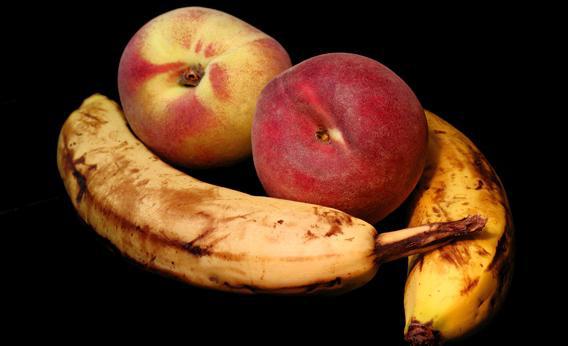Much of the United States has been suffering through a deep freeze for several days, and farmers are starting to express concern about damage to crops. Citrus growers in the West say damage to the fruit has already occurred, although not enough to impact prices. All this damaged fruit has one Explainer reader wondering: Is there anything wrong with eating visibly bruised produce?
Not necessarily. A bruise is an indicator of cellular damage. When you ding an apple or a banana, it can compromise the ability of the skin or the peel to keep oxygen away from the fruit, and oxygen breaks down the cellular walls and membranes. When the chemicals within the fruit become oxidized by enzymes like polyphenoloxidase, the reaction causes an unappealing brown color. There’s no evidence, however, that oxidized fruit is bad for you. Nor is a bruise necessarily indicative of an infection. If you want to cut the bruised portion of your fruit away for aesthetic reasons, by all means do so. There are also plenty of ways to cover up the mushy consistency of bruised fruit—homesteaders turn their bruised fruits into pies, juice, jams, or fruit leathers. But if you can’t be bothered to trim your bruised banana or bake it into bread, there’s little risk to your health in just eating it.
There is a caveat: Bruising makes a piece of fruit more susceptible to infection. As the cell walls break down, nutrients leak into the open, inviting colonization by microbes already present on the surface of the fruit or in the air. As they feed on the fruit’s exposed innards, the cells multiply rapidly. It’s possible for damaged fruit to grow some of the more notorious varieties of food-borne pathogens, such as salmonella or E. coli, but garden-variety yeasts and molds are far more common. Yeasts are of minimal concern—inoculating fruit with yeasts gives us such delights as wine and cider—but molds can be dangerous. Some species of mold release mycotoxins, which can cause a variety of human illnesses. (The most notorious mycotoxin, known as aflatoxin, is a potent carcinogen that grows on milk, cheese, nuts, and grains.) If your bruised fruit has so much fungal activity that you can see or smell it, don’t eat it. In addition to bruised areas, you should check the area around the fruit’s stem for mold, which is an entry point for opportunistic microbes. Food safety experts have a saying: If in doubt, throw it out. Healthy adults often take their chances and get away with it, but this advice is especially important for small children or the elderly.
If your bruised fruit has visible microbial growth, is it still safe to eat the nondamaged portion? It depends on the fruit. The question is whether the roots of the mold have penetrated the food. It’s difficult for mold to grow deep into firm fruits. So feel free to cut away the moldy portion of a bell pepper—yes, bell peppers are a fruit—and eat the remainder. Bananas, on the other hand, are too soft to repel a mold invasion, so a banana with a bruised, moldy spot should be tossed.
Got a question about today’s news? Ask the Explainer.
Explainer thanks Doug Gubler of UC-Davis and Lynne McLandsborough of the University of Massachusetts, Amherst.
